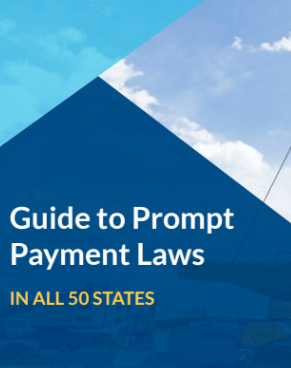What do I need to know about Prompt Payment?
- Prompt Pay Resources
- Top Links
Prompt Payment FAQs
Almost every state (and country) has prompt payment rules, laws, and procedures. It can be really expensive to not follow these requirements. Learn everything you need to know about prompt payment with this guide and FAQs.
Map of Prompt Payment Requirements
Prompt payment rules are different depending on where your job is located. Use our color-coded map to learn more about retainage requirements that may affect your next job.

Free Guide to Prompt Payment Laws In All 50 States
The timing of payments and penalties for non-compliance vary widely. This guide provides an overview of the requirements and penalties in each state as they apply to both private and public projects.
Prompt Payment can refer to a number of different things.
- The Federal Prompt Payment Act
- An individual state’s prompt payment law
- A prompt payment claim made by a party on a construction project
- Generally a faster payment speed
This page is about the prompt payment requirements and rules, codified into federal and state laws. They set payment timeframes on federal, state, and/or private construction projects. These laws provide extra protection to contractors and subcontractors to ensure that payment is made in a timely manner. Both federal and state laws provide the right to interest penalties for late payments.
Prompt Payment Laws
Prompt payment laws provide a framework for the timing of construction payments. Generally speaking, state timeframes are short (i.e. 7-14 days). They usually begin to count from when the paying party received their own payment. Federal timeframes for payment are based upon receipt of a payment request. These deadlines are typically between 15-30 days.
In practice, the rules may not always work as desired. But, they can leave too much wiggle room to be truly effective in speeding up payment. For example; some start the clock for payment upon receipt of a “proper” or “undisputed” request. It’s easy to see how issues could arise with either.
Federal Laws
The US Prompt Payment Act requires federal construction contracts to include a prompt payment clause. This requires the prime to pay subcontractors for “satisfactory” performance within seven days of receipt of payment. However, the timing for payment on non-federal projects varies by state and project type.
- Read the full text of the US Prompt Payment Act
Payments to Small Businesses
In 2011-2012, the Obama Administration provided supplemental guidance regarding the payment of subcontractors vis-a-vis the Prompt Payment Act. Initially requiring the government to pay small business contractors within 15 days of receiving a proper invoice. Subsequently, this was expanded to cover payments to subcontractors. Requiring agencies to “accelerate payments to all prime contractors, in order to allow them to provide prompt payments to small business subcontractors.”
Federal Acquisition Regulation
According to the Federal Acquisition Regulation (FAR Section 52.232-25), the United States Federal Government must make payment to contractors by the later of two events:
- The 30th day after the designated billing office receives a proper invoice from the Contractor
- The 30th day after Government acceptance of supplies delivered or services performed.
- For a final invoice, when the payment amount is subject to contract settlement actions. Acceptance will be deemed to occur on the effective date of the contract settlement.
When payments aren’t timely made, the law assigns a late payment interest penalty that is paid automatically. That is, without the need for a request or demand from the contractor.
State Laws
Nearly every US state has laws that set payment deadlines on construction projects. The timing of payments and penalties for non-compliance vary widely. Most states have laws that apply to both private projects and public projects. However, some states only set requirements for public projects. In some states, the same statute applies to payments on both public and private projects. In others, different laws apply to each type of project.
State prompt payment laws set deadlines for payment on every project tier. Including payments from the property owner to the prime contractor, from the prime to subcontractors, and so on. Furthermore, some states create a distinction between progress payments and final payments, including retainage, with different deadlines for each.
Demanding Payment & Penalties
Prompt payment requirements are just another form of payment protection. These are built into the law to benefit construction industry participants. Yet, they are often overlooked. Therefore, best practice is to reference these prompt payment laws early and often.
For example. If sending a demand letter for payment, you’ll want to include a reference to the applicable prompt payment statutes. That’s because they may entitle you to recover costs, interest penalties, and attorney fees!
- Learn how to write a prompt payment demand letter
- Download a free Prompt Payment Demand Letter template
Making a Prompt Payment Claim
Generally, making a prompt payment claim requires filing a lawsuit in civil court. The court will determine the validity of the claim. If successful, they’ll impose any penalties due according to the law. Most states apply interest penalties to late payments. And some also allow the claimant to recover attorney fees and court costs.

